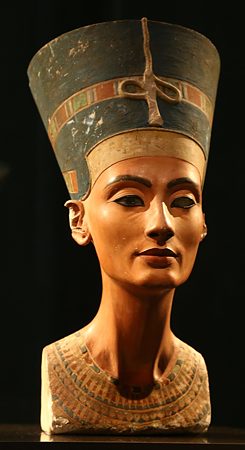Repatriation Debate
The Restitution of Colonial Artefacts Is Going Slowly

Where do they belong? Ownership claims to cultural assets from the colonial period are often controversial and negotiating possible restitution is frequently a fraught and drawn-out process. Germany is taking some initial steps towards a resolution.
By Wolfgang Mulke
Used by Portuguese colonial rulers to proclaim their ownership of Cape Cross in southern Africa, the column is 3.50 metres high, at least 530 years old, and crowned by a limestone cross. According to the Portuguese coat of arms, it was first erected in 1485 and remained in Africa until 1893, when German colonists who had taken over the territory brought the historical cultural object to Berlin. Now its return journey is just around the corner: Germany has agreed to return the Stone Cross of Cape Cross to Namibia. Federal Government Commissioner for Culture of the Media Monika Grütter called the decision “progressive and meaningful”.
So far though, restitution is more the exception than the rule in Germany. The state of Baden-Württemberg’s decision to return Namibian national hero Hendrik Witbooi’s bible and whip to the Namibian government at the beginning of 2019 is another shining example. Otherwise, restitution has been limited to human remains, such as the skulls of Australian natives, and grave goods from African countries. The ruling coalition of social democrats and conservatives has made a commitment to come to terms with its colonial past, indicating in its government programme that exploring the crimes committed during this period must become part of the national culture of remembrance.
 Namibian national hero Hendrik Witbooi probably never dreamed that his whip and bible would one day be the stuff of international controversy.
| Photo (detail): © picture-alliance/dpa
Namibian national hero Hendrik Witbooi probably never dreamed that his whip and bible would one day be the stuff of international controversy.
| Photo (detail): © picture-alliance/dpa
Limited debate around the colonial past
So far, Germany has failed to take an in-depth look at the German Empire at the end of the 19th and beginning of the 20th century. Awareness of the crimes committed during this period has only recently entered the public consciousness, in part due to the debate about the mass murder of the Nama and Herero tribes by German colonial troops in Namibia. The Federal Government is seeking reconciliation with the former colony, including the restitution of stolen cultural assets.
German museums hold thousands of artefacts from all over the world. The exact number is unknown, as is whether they were acquired legally. These include spectacular pieces like the bust of Egyptian pharaoh Nefertiti. Egypt’s demands to have it returned have fallen on deaf ears so far. Then there is the 13-metre long skeleton of a dinosaur in the Berlin Museum of Natural History German scientists discovered and removed from Tanzania.
Provenance research as a starting point
 Ongoing restitution battle: who is the true owner of the bust of Nefertiti?
| Photo (detail): © picture alliance / Eventpress Herrmann
Obviously the guardians of these treasures are not particularly inclined to give up such significant finds. In 2019, however, the federal and state governments agreed on some key points for dealing with these treasures. Their statement reads:”We want to create the conditions for the repatriation of human remains and of cultural goods from colonial contexts whose appropriation is no longer legally or ethically justifiable today.” In practice, Grütters began by supporting more provenance research, that is establishing the origin and circumstances of the acquisition of cultural assets.
Ongoing restitution battle: who is the true owner of the bust of Nefertiti?
| Photo (detail): © picture alliance / Eventpress Herrmann
Obviously the guardians of these treasures are not particularly inclined to give up such significant finds. In 2019, however, the federal and state governments agreed on some key points for dealing with these treasures. Their statement reads:”We want to create the conditions for the repatriation of human remains and of cultural goods from colonial contexts whose appropriation is no longer legally or ethically justifiable today.” In practice, Grütters began by supporting more provenance research, that is establishing the origin and circumstances of the acquisition of cultural assets.
This decision has been met with fierce criticism. Hamburg historian Jürgen Zimmerer sees the focus on provenance research as a strategy to postpone the necessary political resolutions. He fears this could promote “colonial amnesia” rather than drive the public discourse needed. “Dealing with Europe’s colonial heritage is one of the great, if not the greatest, identity debates of our time,” Zimmerer writes. Instead of research into the origins of an object, he calls for reversing the burden of proof, suggesting colonial collections should have to prove the items in their possession were acquired legally. If not, the items in question should automatically be seen as looted artefacts.
France might be leading the way
The German government is also under pressure from French President Emmanuel Macron, who is eager to reach an agreement with African states on the return of colonial goods housed in France. The president was inspired in part by the work of French art historian Bénédicte Savoy, who teaches at the Technical University of Berlin, and economist Felwine Sarr. In a commission report, they encouraged Macron pursue the permanent restitution of stolen art.
Savoy’s demands also echo in the halls of Berlin. Here the controversy centres on the Humboldt Forum. The museum will unite the non-European and Asian collections of the Prussian Cultural Heritage Foundation with tens of thousands of pieces of questionable origin and be displayed in the rebuilt imperial city palace. In 2017, Savoy quit the Forum Advisory Board in protest, partly because of a lack of transparency and neglected provenance research.
Comments
Comment